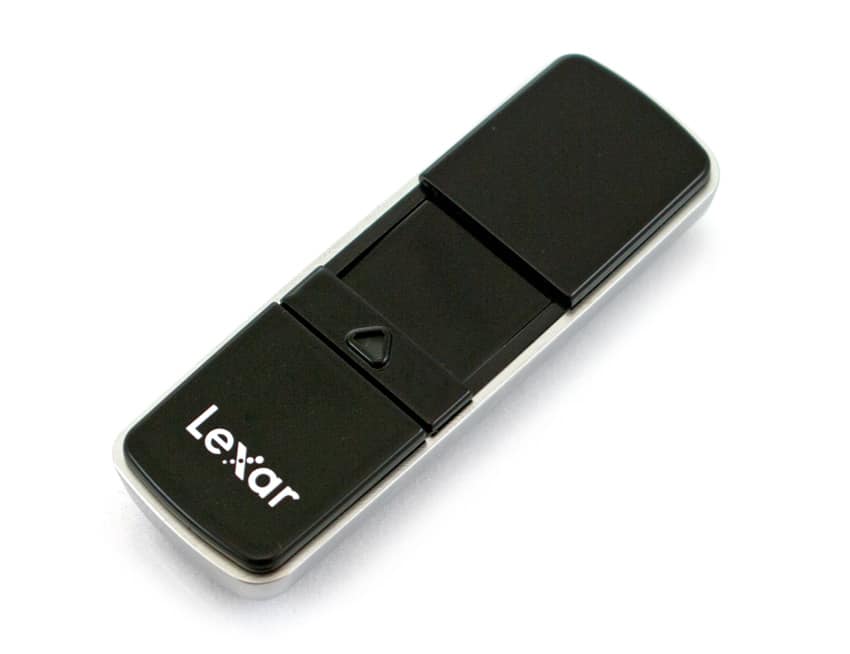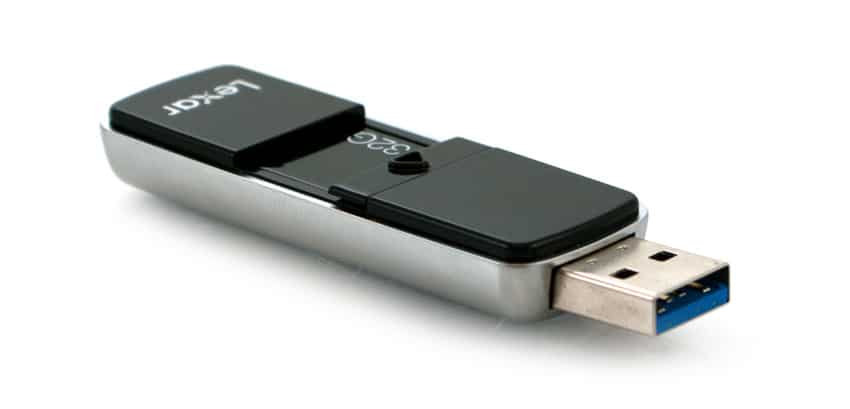
The Lexar JumpDrive P10 is a flash drive that connects over USB 3.0 and is billed as one of the fastest flash drives on the market with its transfer rates quoted at up to 265MB/s for read activity and 245MB/s for write activity. That Lexar figure equates to roughly 1GB every four seconds or 15GB a minute. Beyond that, the JumpDrive P10 arrives in three different capacity points: 16GB, 32GB and 64GB. So, for example, if you take the performance spec and calculate it with the maximum capacity point of 64GB, transferring the contents of a JumpDrive P10 filled with a maximum data load would only take roughly 4-5 minutes. On top of that, Lexar has implemented a more premium build with metal-alloy to match the JumpDrive P10’s appearance to its high-end performance.

Essentially, the JumpDrive P10 is designed for anyone who works with robust media file sizes including gamers, everyday and enthusiast photographers, and those with large movie and music collections. Average run of the mill flash drives just aren’t designed for those applications; they are engineered to handle quick document transfers, moving around a single CD, storing a day’s worth of photos, etc. The JumpDrive P10 and other high performance flash drives are in a wholly separate class that pushes performance to SSD-type speeds.
The Lexar JumpDrive P10 is available now with street pricing at $43 for the 16GB, $69 for the 32GB and $121 for the 64GB. That includes a lifetime warranty. Our test JumpDrive P10 is the 32GB model.
Lexar JumpDrive P10 Specifications
- Capacities
- 16GB (up to 260MB/s read, 180MB/s write)
- 32GB (up to 265MB/s read, 245MB/s write)
- 64GB (up to 265MB/s read, 245MB/s write)
- Among the fastest USB flash drives available—up to 24x faster than speed-rated USB 2.0 drives
- Sleek design with metal alloy base and high-gloss mirror finish top
- Reliably stores and transfers files, photos, videos, and more
- Compatible with PC and Mac systems
- Limited lifetime warranty
Design and Build
The JumpDrive P10 flash drive features a retractable USB 3.0 connector at the top, making it easier to keep the drive secure and protect the connector from breaking. On the back side, the P10 features a metal-alloy casing, while the front side features a high-gloss surface. The front also features the branding.
There is an arrow with an LED indicator built-in. That’s where users can slide the retractable connector to protect the unit when it’s not in use.
Performance
Using our Consumer Testing Platform, we measured transfer speeds from the Lexar JumpDrive P10 32GB with IOMeter. Sequential read activity measured 252.39MB/s, while write activity hit 225.89MB/s. Random large-block transfers measured 167.72MB/s read and 14.83MB/s write. While the sequential figures didn’t quite hit the 265MB/s and 245MB/s mark, they were quite close.
Comparing the Lexar JumpDrive P10, we also tested the similarly priced Kingston DataTraveler HyperX 3.0. With it, sequential read activity measured 199.20MB/s, while write activity hit 116.69MB/s. Random large-block transfers measured 161.68MB/s read and 4.35MB/s write.
In sequential activity, the Lexar JumpDrive P10 has the clear advantage, and while the Kingston kept up in random transfer reads, its write activity also fell short of the P10’s.
We also wanted to compare the JumpDrive P10 to the Kingston HyperX Predator 512GB model that we’ve tested. It’s extremely important to note the giant price delta between the two, as the HyperX Predator currently runs in the $600 price range for 512GB and the 1TB model runs $1,200. Obviously the two play in a different space in that regard, but it’ll be interesting to see which performs better. When we tested the Kingston HyperX Predator, 2MB sequential read and write speeds measured 233.2MB/s and 160.5MB/s respectively, while random large-block transfers measured 149.3MB/s read and 37.62MB/s write. The JumpDrive P10 actually outperformed the HyperX by a pretty solid margin in sequential activity and also held the edge in random transfer reads, but in random transfer write the HyperX was tops.
Conclusion
The Lexar JumpDrive P10 has ultra-fast transfer rates that Lexar quotes at 265MB/s for read activity and 245MB/s for write activity on our 32GB tester and the 64GB as well. That Lexar figure is right up there with speeds produced by SSDs, meaning that in the highly portable flash drive form factor, users can attain performance much greater than HDDs. Applications are thus tailored less toward moving around Word files, a few CDs worth of MP3s, or some recent photographs, and more toward enthusiast type users or even those with expansive media libraries full of music and movies. To match that strong performance, Lexar engineered the exterior design of the JumpDrive P10 with more premium accents.
As is typical with this type of product, we tested the Lexar JumpDrive P10 over IOMeter. It performed with extremely high marks. The P10 didn’t quite achieve the marks that Lexar quoted, but was very close at 252MB/s read and 226MB/s write (versus 265/245). At the same time, when we compared the flash drive to a similarly priced Kingston, the DataTraveler HyperX 3.0, the P10 won out handily, especially in sequential activity and random writes. We also compared the P10 against the far more expensive Kingston HyperX Predator, which also features a 512GB minimum capacity, and the P10 performed better again in sequential activity. The P10 also proved faster in random reads, but was outperformed in random writes. Overall, the figures were quite impressive, especially given the price-point.
Pros
- Strong sequential performance with 254MB/s read and 225MB/s write
- Largely outperformed comparables, including far more expensive model
Cons
- 64GB maximum capacity limits some creatives from selecting the P10
Bottom Line
The Lexar JumpDrive P10 features performance similar to what users expect from SSDs in the flash drive form factor that makes these types of devices far easier to transport and tote around than portable drives.
Lexar JumpDrive P10 a Amazon.com

